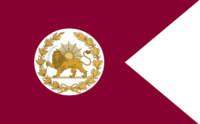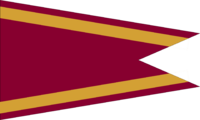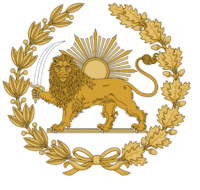Royal Qalehi Navy: Difference between revisions
No edit summary |
|||
| (11 intermediate revisions by the same user not shown) | |||
| Line 1: | Line 1: | ||
{{WIP}} | |||
{{Infobox military unit | {{Infobox military unit | ||
|unit_name= Qalehi Navy | |unit_name= Qalehi Navy | ||
| Line 22: | Line 23: | ||
|march= "''نیروی دریایی مارس''" ({{lang-en|"Naval March"}})[[https://www.youtube.com/watch?v=kU6UKH51Q1Q|1]] | |march= "''نیروی دریایی مارس''" ({{lang-en|"Naval March"}})[[https://www.youtube.com/watch?v=kU6UKH51Q1Q|1]] | ||
|mascot= | |mascot= | ||
|equipment=1 {{wp|light aircraft carrier|light aircraft carriers}}<br />8 {{wp|cruiser}}s<br /> | |equipment=1 {{wp|light aircraft carrier|light aircraft carriers}}<br />8 {{wp|cruiser}}s<br />13 {{wp|destroyer}}s<br />13 {{wp|corvette}}s<br />17 {{wp|submarine}}s<br />11 {{wp|frigate}}s<br />30 {{wp|patrol boat}}s<br />7 {{wp|mine countermeasures vessel}}s<br />4 {{wp|amphibious assault ship}}s | ||
|equipment_label= | |equipment_label= | ||
|battles= [[Qalehi Civil War]]<br>[[Kasahgan War]]<br />[[Arian Summer]] | |battles= [[Qalehi Civil War]]<br>[[Kasahgan War]]<br />[[Arian Summer]] | ||
| Line 33: | Line 34: | ||
|commander2={{wp|Admiral}} Farhad Loristani | |commander2={{wp|Admiral}} Farhad Loristani | ||
|commander2_label= Admiral | |commander2_label= Admiral | ||
|commander3={{wp|Vice Admiral}} Salman | |commander3={{wp|Vice Admiral}} Salman Aktari | ||
|commander3_label= Vice Admiral | |commander3_label= Vice Admiral | ||
|commander4= | |commander4= | ||
| Line 39: | Line 40: | ||
|notable_commanders= | |notable_commanders= | ||
<!-- Insignia --> | <!-- Insignia --> | ||
|identification_symbol= | |identification_symbol= [[File:Qal'eh_navy_flag.png|200px|left]] | ||
|identification_symbol_label= | |identification_symbol_label= Flag | ||
|identification_symbol_2= | |identification_symbol_2= [[File:Qal'eh_navy_jack.png|200px|left]] | ||
|identification_symbol_2_label= | |identification_symbol_2_label= Jack | ||
|identification_symbol_3= | |identification_symbol_3= [[File:Qal'eh_navy_pennant.png|200px|left]] | ||
|identification_symbol_3_label= | |identification_symbol_3_label= Pennant | ||
|identification_symbol_4= | |identification_symbol_4= | ||
|identification_symbol_5 = | |identification_symbol_5 = | ||
| Line 63: | Line 64: | ||
The '''Royal Qalehi Navy''' ({{wp|farsi|Qalehi}}: نیروی دریایی سلطنتی قله), commonly abbreviated to '''RQN''', is the naval warfare branch of the [[Qalehi Armed Forces]], the military of [[Qal'eh]]. | The '''Royal Qalehi Navy''' ({{wp|farsi|Qalehi}}: نیروی دریایی سلطنتی قله), commonly abbreviated to '''RQN''', is the naval warfare branch of the [[Qalehi Armed Forces]], the military of [[Qal'eh]]. | ||
The navy | The navy forms Qal'eh's first line of defense in the Decanian Sea, and is pivotal in the protection of national sovereignty. The navy also plays a large role in the administration of the [[Kasahgan Peninsula]]. | ||
The sole maritime branch of the Qalehi Armed Forces, the RQN holds all of Qal'eh's naval prowess, including large attack ships like destroyers, frigates and cruisers. As well as tactically-oriented ships, such as amphibious assault craft, all four of which are important for the projection of Qalehi power overseas. | The sole maritime branch of the Qalehi Armed Forces, the RQN holds all of Qal'eh's naval prowess, including large attack ships like destroyers, frigates and cruisers. As well as tactically-oriented ships, such as amphibious assault craft, all four of which are important for the projection of Qalehi power overseas. | ||
== Overview == | |||
[[File:Vencedora_F36.jpg|thumb|230px|left|''HQMS Dahrzor'' (CV-001) on its maiden voyage in 1978]] | |||
The Royal Qalehi Navy underwent a massive modernisation program in the 1970s and 80s after the collapse of the [[FSR]] following the [[FSR Civil War]] primarily initiated by Farid Hashempour Rouhani, the 12th Shahanshah of Qal'eh. The aim of the modernisation program was to secure Qalehi naval dominance in the Decanian Sea and to take advantage of its neighbouring, ex-FSR countries' dwindling industries due to post-civil war damages. The {{wp|Descubierta-class corvette|Dahrzor-class corvette}} in 1978 and the {{wp|Almirante Brown-class destroyer|Arzet-class destroyer}} in 1982 were the first ships to be laid down as part of the modernisation program. The ships allowed for Qalehi power projection across the coastal states of [[Sifhar]] and strengthened its trading capabilities with the countries of northern [[Majula]] and sometimes even as far as [[Asura]], [[Arabekh]] and [[Catai]]. | |||
[[File:JS_Hakuryu_(SS-503)_arrives_at_Joint_Base_Pearl_Harbor-Hickam_for_a_scheduled_port_visit,_-6_Feb._2013_(YP255-023).jpg|thumb|230px|left|''HQMS Qori'' (SU-053) in [[Sidi Synnia]] in 2014]] | |||
The modernisation program continued successfully and in 1983 Hossein Nemati Rouhani | |||
approved 141.5 billion Zaar (~$50 billion) of funding to be designated to the RQN's modernisation program starting in 1984 and ending in 1989, almost the entire military budget at the time. As a result of this vastly disproportionate funding, the army and air force suffered, the air force in particular suffered a 50% personnel callback and 30% of its equipment being decommissioned, sold or scrapped. | |||
[[File:DD-116Teruduki&DD117Suzutuki.JPG|230px|thumb|left|''HQMS Aftab'' (DE-116) and ''HQMS Bulamaj'' (DE-117) at the Khazam Yek Shipyard in 2015]] | |||
Navy funding has been curtailed in Qal'eh today, although it still remains the most funded branch of the [[Qalehi Armed Forces|armed forces]]. The navy's main surface combat ship is the {{wp|Akizuki-class destroyer (2010)|Aftab-class destroyer}}, introduced in 2011, of which the RQN operates eight to replace its aging Arzet-class destroyers. The RQN is also beginning to focus more on its fleets' speed, shock and manoeuvrability as opposed to its surface brute-force power. The increase in smaller, quicker and more modern ships like the {{wp|Visby-class corvette|X-class corvette}} and the increase in submarines coupled with the 2010 introduction of the {{wp|Sōryū-class submarine|X-class submarine}} to modernise its submarine fleet and to introduce air-independent propulsion into the country's submarine fleet. The country has ''de facto'' navally allied itself with [[Sidi Synnia]] and the two countries regularly work together in naval development as well as anti-piracy operations throughout [[Sifhar]]. | |||
== History == | |||
While the navies of countries such as the [[Hammurian Empire]] and [[Haydarid Caliphate]] have often had fleets based in Qal'eh, the first navy of the kingdoms of empires of Qal'eh itself was that of the [[Assadian Caliphate]], established in 1027, whose fleet regularly established trade links with either states in western [[Sifhar]] and northern [[Majula]]. While the Assadids were not an overly sea-faring civilisation, their navy was well-maintained and effective, albeit small. The modern iteration of the Royal Qalehi Navy was established in 1802 when Amin Rouhani proclaimed the Sublime State of Qal'eh. The early RQN consisted mainly of ships, barques, brigs and topsail schooners which it used mainly defensively and rarely offensively to try and deter colonial aggression from Asuran powers. The navy was also sometimes used as a way to protect trade coming from eastern [[Catai]] into the Decanian Sea and also to deter pirates from operating in the region, a problem which had plagued the area for a long time. | |||
[[File:Barkskibs_staende_rigning2.png|200px|left|thumb|The rigging of the ''HQMS Amin'', a barque commissioned in 1828]] | |||
Qal'eh had a general distaste for Asuran colonial powers, but one exception was the [[Veleaz|Veleazan Empire]], the country's navy benefited massively from Veleaz's presence in the region. The two nations enjoyed warm relations, which formally culminated in the signing of the X Agreements in 1841, exchanging Veleazan naval training, technology and innovation for Qal'eh to use its navy to protect the Veleazan Orient (now modern-day [[Hisaristan]]), so that Veleaz could move its navy to protect its other colonial holdings. The influence of Veleazan technology and innovation on the RQN was felt instantly, with bigger and better ships being laid down and commissioned almost immediately after the signing of the agreements. Some Veleazan naval experts chose to start naval schools in Qal'eh, and the existence of these schools is often attributed to the success of the RQN today, and Qal'eh's ability to produce high-quality ships. | |||
== Navy ship == | |||
== Navy aviation == | |||
== Procurement of naval equipment == | |||
== Facilities == | |||
== List of currently commissioned RQN ships == | |||
{|class="wikitable sortable nowraplinks" | |||
|- | |||
!Ship name | |||
!Hull no. | |||
!Class | |||
!Type | |||
!Commission date | |||
!Homeport | |||
|- | |||
|align="center"|''HQMS Omid Yazdan'' | |||
|align="center"|CR-009 | |||
|align="center"|{{wp|Kuznetsov-class aircraft carrier|Omid Yazdan-class}} | |||
|align="center"|{{wp|Aircraft carrier}} | |||
|align="center"|18 June 1996 | |||
|align="center"|Khazam Yek | |||
|- | |||
|align="center"|''HQMS Parwaza'' | |||
|align="center"|CS-062 | |||
|align="center"|{{wp|Ticonderoga-class cruiser|Berazend II-class}} | |||
|align="center"|{{wp|Cruiser}} | |||
|align="center"|5 January 2000 | |||
|- | |||
|align="center"|''HQMS Shala'' | |||
|align="center"|CS-062 | |||
|align="center"|{{wp|Ticonderoga-class cruiser|Berazend II-class}} | |||
|align="center"|{{wp|Cruiser}} | |||
|align="center"|5 January 2000 | |||
|- | |||
[[Category:Qal'eh]] | |||
{{Template:Qal'eh}} | |||
Latest revision as of 21:15, 3 July 2019
This article is incomplete because it is pending further input from participants, or it is a work-in-progress by one author. Please comment on this article's talk page to share your input, comments and questions. Note: To contribute to this article, you may need to seek help from the author(s) of this page. |
| Qalehi Navy | |
|---|---|
| نیروی دریایی سلطنتی قله | |
 Seal of the Royal Qalehi Navy | |
| Active | 1802–present |
| Country | |
| Type | Navy |
| Role | Naval warfare |
| Size | 58,900 active duty (2017) |
| Part of | Qalehi Armed Forces |
| Headquarters | Narawh Square, Dahrzor |
| Motto(s) | "برای شاه و کشور" (For Shah and country) |
| Colors | White, Gold, Burgundy |
| March | "نیروی دریایی مارس" (English: "Naval March")[[1]] |
| Equipment | 1 light aircraft carriers 8 cruisers 13 destroyers 13 corvettes 17 submarines 11 frigates 30 patrol boats 7 mine countermeasures vessels 4 amphibious assault ships |
| Engagements | Qalehi Civil War Kasahgan War Arian Summer |
| Commanders | |
| Commander of the Navy | Shahanshah Ahmad Rouhani |
| Admiral | Admiral Farhad Loristani |
| Vice Admiral | Vice Admiral Salman Aktari |
| Insignia | |
| Flag | |
| Jack | |
| Pennant | |
The Royal Qalehi Navy (Qalehi: نیروی دریایی سلطنتی قله), commonly abbreviated to RQN, is the naval warfare branch of the Qalehi Armed Forces, the military of Qal'eh.
The navy forms Qal'eh's first line of defense in the Decanian Sea, and is pivotal in the protection of national sovereignty. The navy also plays a large role in the administration of the Kasahgan Peninsula.
The sole maritime branch of the Qalehi Armed Forces, the RQN holds all of Qal'eh's naval prowess, including large attack ships like destroyers, frigates and cruisers. As well as tactically-oriented ships, such as amphibious assault craft, all four of which are important for the projection of Qalehi power overseas.
Overview
The Royal Qalehi Navy underwent a massive modernisation program in the 1970s and 80s after the collapse of the FSR following the FSR Civil War primarily initiated by Farid Hashempour Rouhani, the 12th Shahanshah of Qal'eh. The aim of the modernisation program was to secure Qalehi naval dominance in the Decanian Sea and to take advantage of its neighbouring, ex-FSR countries' dwindling industries due to post-civil war damages. The Dahrzor-class corvette in 1978 and the Arzet-class destroyer in 1982 were the first ships to be laid down as part of the modernisation program. The ships allowed for Qalehi power projection across the coastal states of Sifhar and strengthened its trading capabilities with the countries of northern Majula and sometimes even as far as Asura, Arabekh and Catai.

The modernisation program continued successfully and in 1983 Hossein Nemati Rouhani approved 141.5 billion Zaar (~$50 billion) of funding to be designated to the RQN's modernisation program starting in 1984 and ending in 1989, almost the entire military budget at the time. As a result of this vastly disproportionate funding, the army and air force suffered, the air force in particular suffered a 50% personnel callback and 30% of its equipment being decommissioned, sold or scrapped.
Navy funding has been curtailed in Qal'eh today, although it still remains the most funded branch of the armed forces. The navy's main surface combat ship is the Aftab-class destroyer, introduced in 2011, of which the RQN operates eight to replace its aging Arzet-class destroyers. The RQN is also beginning to focus more on its fleets' speed, shock and manoeuvrability as opposed to its surface brute-force power. The increase in smaller, quicker and more modern ships like the X-class corvette and the increase in submarines coupled with the 2010 introduction of the X-class submarine to modernise its submarine fleet and to introduce air-independent propulsion into the country's submarine fleet. The country has de facto navally allied itself with Sidi Synnia and the two countries regularly work together in naval development as well as anti-piracy operations throughout Sifhar.
History
While the navies of countries such as the Hammurian Empire and Haydarid Caliphate have often had fleets based in Qal'eh, the first navy of the kingdoms of empires of Qal'eh itself was that of the Assadian Caliphate, established in 1027, whose fleet regularly established trade links with either states in western Sifhar and northern Majula. While the Assadids were not an overly sea-faring civilisation, their navy was well-maintained and effective, albeit small. The modern iteration of the Royal Qalehi Navy was established in 1802 when Amin Rouhani proclaimed the Sublime State of Qal'eh. The early RQN consisted mainly of ships, barques, brigs and topsail schooners which it used mainly defensively and rarely offensively to try and deter colonial aggression from Asuran powers. The navy was also sometimes used as a way to protect trade coming from eastern Catai into the Decanian Sea and also to deter pirates from operating in the region, a problem which had plagued the area for a long time.
Qal'eh had a general distaste for Asuran colonial powers, but one exception was the Veleazan Empire, the country's navy benefited massively from Veleaz's presence in the region. The two nations enjoyed warm relations, which formally culminated in the signing of the X Agreements in 1841, exchanging Veleazan naval training, technology and innovation for Qal'eh to use its navy to protect the Veleazan Orient (now modern-day Hisaristan), so that Veleaz could move its navy to protect its other colonial holdings. The influence of Veleazan technology and innovation on the RQN was felt instantly, with bigger and better ships being laid down and commissioned almost immediately after the signing of the agreements. Some Veleazan naval experts chose to start naval schools in Qal'eh, and the existence of these schools is often attributed to the success of the RQN today, and Qal'eh's ability to produce high-quality ships.
Facilities
List of currently commissioned RQN ships
| Ship name | Hull no. | Class | Type | Commission date | Homeport |
|---|---|---|---|---|---|
| HQMS Omid Yazdan | CR-009 | Omid Yazdan-class | Aircraft carrier | 18 June 1996 | Khazam Yek |
| HQMS Parwaza | CS-062 | Berazend II-class | Cruiser | 5 January 2000 | |
| HQMS Shala | CS-062 | Berazend II-class | Cruiser | 5 January 2000 |
Population: 52,981,727 · Capital: Dahrzor · Languages: Qalehi, Arvian | ||
| History | ||
| Politics | ||
| Military | ||
| Geography | ||
| Economy | ||
| Demographics | ||
| Culture | ||
| Symbols | ||






